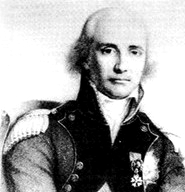General Armand Samuel de Marescot

Born: March 1, 1758
Place of Birth: Tours, Indre-et-Loire, France
Died: November 5, 1832
Place of Death: Montoire, France
Arc de Triomphe: MARESCOT on the east pillar
Pronunciation:
The son of soldier in the corps of the guard of the King, Armand Samuel de Marescot initially studied at the college of La Flèche. He went to engineering school in 1776 and then two years later he was a sous-lieutenant of engineers at the school of Mézières. In 1780 Marescot was promoted to lieutenant and then in 1784 he finally left the school of Mézières.
After the onset of the Revolution Marescot was promoted to capitaine in April of 1791. A year later he was at the affair of Pas-de-Baisieux where he was almost massacred, but he survived unlike General Dillon. Afterwards Marescot set out to prepare the defense of the frontier and in particular prepare Lille for an attack. He was named a Knight of Saint Louis in 1792 and that October he was wounded at the bombardment of Lille. Next he served in Belgium as an aide-de-camp to Champmorin and he took part in the action of Antwerp. In 1793 after the Battle of Neerwinden Marescot returned to Lille where he prepared the defenses of the city. Next he was denounced by the revolutionary club of Lille and therefore he was called to Paris to defend himself. Having defended himself, Marescot was promoted to chef de bataillon in November of 1793 and he then went to serve at the Siege of Toulon . During the siege he directed the works to approach and he was wounded at the advance posts of the grand redoubt.
In January of 1794 Marescot was sent to command the engineers at Maubeuge. That year he was very busy, serving at the sieges of Charleroi and then ordering the attack on Landrecies which he took after seven days. For this he was promoted to chef de brigade and in August he took command of the engineers at the siege of Quesnoy, the siege of Valenciennes, and the siege of Condé. For all this work Marescot was promoted to général de brigade. He was next sent to direct the engineers at the siege of Maestricht which surrendered in November and he was recognized with another promotion, this time to général de division. In March of 1795 Marescot was included in a list of émigrés and therefore his belongings were confiscated and put up for sale, but Carnot intervened and ensured Marescot's belongings were returned. At this time Marescot also became inspector general of engineers and then he was sent to Bayonne to command the engineers of the Army of the Western Pyrenees. In 1796 Marescot was named commander at Landau and that October he repulsed an attempt against Landau by Hotze. He next served at the defense of Kehl and then in 1797 he was named commander-in-chief of the engineers of the Army of the Rhine. That April he served at the crossing of the Rhine at Kehl. As the armies were being reorganized, Marescot commanded the engineers of the Army of Germany, the Army of England, the Army of the Danube, and the Army of Switzerland through 1797 to 1799. He was named governor of Mainz in September of 1799.
After Napoleon took power as First Consul, Marescot was named inspector general of engineers. Next he was appointed commander of the engineers of the Army of the Reserve, and in this capacity he and his men ensured the army successfully crossed the Great Saint-Bernard pass. Afterwards he laid siege to Fort Bard and then he assisted at the Battle of Marengo. During the peace that followed, Marescot was named president of the committee of fortifications. He inspected the coasts of Rochefort and Antwerp and then in 1803 he took command of the engineers of the Army of the Coasts of the Ocean. In 1804 Marescot was named the premier inspector general of engineers and in 1805 he received the Grand Eagle of the Legion of Honor. Later that year as the war with the Third Coalition got underway, Marescot served with the Grande Armée during the campaign in Austria.
In 1808 Marescot was named a Count of the Empire and sent to inspect Cadiz, Algésiras, and Gibraltar. Afterwards he joined General Dupont's corp at Andujar in June and therefore he was with Dupont during the disastrous Battle of Bailen in July. Marescot negotiated the surrender and he was taken prisoner and sent from Cadiz to Marseille. Back in France he was dismissed from his rank and had his awards stripped from him, and then he was sent to the prison of l'Abbaye in Paris. Marescot remained in prison until 1812 when he was tried by a council of inquiry and released, but exiled to Tours. After Napoleon's abdication and the Bourbon Restoration, the Bourbons restored Marescot's rank and awards. He was also named a Commander of Saint Louis. When Napoleon returned to power for the Hundred Days, Napoleon named Marescot to the committee of defense and then sent him as inspector general of engineers of Argonne and Vosges. After the Second Restoration, Marescot retired.
Bibliography
- Divry, Arnauld. Les Noms Gravés sur l'Arc de Triomphe. Paris: L'Harmattan, 2017.
- Six, Georges. Dictionnaire Biographique des Généraux & Amiraux Français de la Révolution et de l'Empire (1792-1814). 2 vols. Paris: Gaston Saffroy, 2003.
Updated March 2018
© Nathan D. Jensen